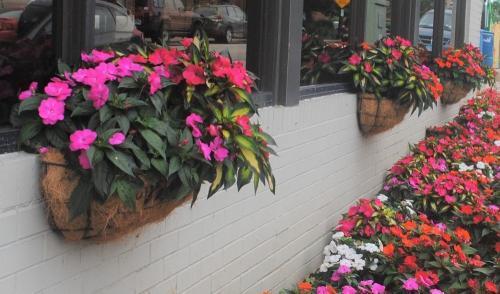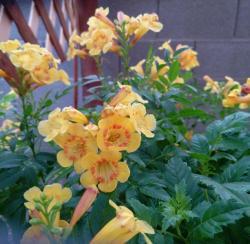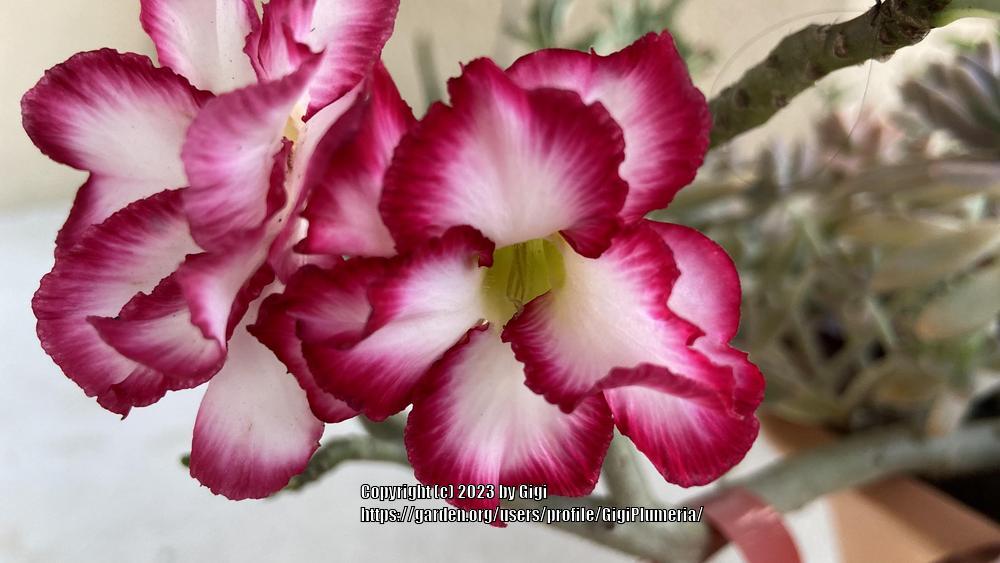 In the Spring, I have counted 136 different kinds of weather inside of 24 hours. -Mark Twain In the Spring, I have counted 136 different kinds of weather inside of 24 hours. -Mark Twain
|
|
There's Always Space for Another Garden
Maybe you've been dreaming of a small vegetable patch or new perennial planting. Or perhaps there's a section of lawn that's a hassle to mow. Now is the time to build the new gardens. Remember, no space is too small for a few attractive plants! |  |
|
|
How to Grow and Care for Coral Bells
Coral bells sport airy flower spikes on wiry stems above low-growing, often dramatic foliage. Varieties with variegated or dark purple leaves make stunning ground covers, and the delicate flower spikes won't obscure the plants behind them. |  |
|
|
Edible Landscaping: Figs
Fig trees are easy to grow, produce abundantly for years, and the fruits are sweet and tasty eaten fresh or dried. They can be planted outdoors in warm climates or grown in containers in colder climates. |  |
|
|
Transplanting Annuals
Annuals -- plants that sprout, bloom, set seeds, and die in one growing season -- provide some of the brightest and most reliable colors in the landscape. Help young plants make the transition to the garden with these tips. |  |
|
|
Downy Mildew
Various types of downy mildew fungi cause disease in a number of crops all over the United States. Irregular brown or yellow spots develop on the upper leaf surface; the lower leaf surface beneath these spots is covered with a hairy white or purple mold during humid weather. |  |
|
|
Container Plants Inspiration
Looking to make a splash with your container plantings this year? Consider branching out this year and trying some new plants and creative combinations. Here are some tips to help you choose plants. |  |
|
|
Up On the Roof
Gardening on a rooftop or exposed balcony is a demanding endeavor. The challenge has given me a new appreciation for plants and their tenacity for life. If you're starting from scratch, here are some things to keep in mind. |  |
|
|
Stringy Stonecrop (Sedum sarmentosum)
Hardiness: Hardy - Can Handle Freezing Temps
Evergreen: Yes
Growth Habit: Ground cover, Mat Forming, Trailing
Soil Type: Dry, Well drained, Loamy / Medium, Sandy / light, Good draining potting mix
Plant uses and characteristics: Border, Containers, Pest resistant, Average water needs, Does not like wet feet
Plant Habit: Cactus/Succulent
Sun Requirements: Full Sun to Partial Shade
Water Preferences: Mesic, Dry Mesic, Dry
Plant Height: 4 - 6 inches
Plant Spread: 24 inches
Leaves: Evergreen, Deciduous, Other
Flowers: Showy
Flower Color: Yellow
Flower Time: Spring, Late spring or early summer
Uses: Groundcover, Will Naturalize
Wildlife Attractant: Butterflies, Bees
Resistances: Deer Resistant, Rabbit Resistant, Drought tolerant
Pollinators: Various insects
Containers: Suitable in 1 gallon, Suitable in 3 gallon or larger, Needs excellent drainage in pots
|  |
|
|
Daylily (Hemerocallis 'Pink Stripes')
Hybridizer: Derrow
Year of Registration or Introduction: 2006
Foliage type: Dormant
Scape height: 30 inches
Bloom size: 7 inches
Bloom time: Early midseason
Plant Traits: Diurnal
Bud Count: 21-25
Branching: 2-way
Bloom Traits: Dotted, Stippled, Streaked or Variegated
Bloom Form: Single
Color description: magenta rose with pink cream stripping above gold orange throat
AHS Awards: Honorable Mention
Plant Habit: Herb/Forb
Life cycle: Perennial
Sun Requirements: Full Sun to Partial Shade
Minimum cold hardiness: Zone 3 -40 °C (-40 °F) to -37.2 °C (-35)
Flowers: Showy
Ploidy: Diploid
Parentage: Pink Brocade x Peppermint Parfait
|  |
|
|
Rose (Rosa 'Gypsy')
Bloom size: Large: 4-5"
Bloom shape: High-centered
Petal count: full: 26-40 petals
Rose bloom color: Dark red
Rebloom: Good
Class: Hybrid tea
Extra Color Info: Dark orange-red
Growth Habit: Medium-tall, 4-5 feet, upright
Fragrance: Mild
Hybridizer & year: Swim & Weeks, 1972
Optimal growing zones: USDA zone 7 and warmer
Awards: AARS
Plant Habit: Shrub
Life cycle: Perennial
Sun Requirements: Full Sun
Minimum cold hardiness: Zone 7b -15 °C (5 °F) to -12.2 °C (10 °F)
Plant Height: 4-5 feet
Plant Spread: 2-3 feet
Leaves: Deciduous
Flowers: Showy, Fragrant
Flower Color: Red
Flower Time: Spring, Summer, Fall
Uses: Cut Flower
Wildlife Attractant: Bees
Parentage: ((Happiness x Chrysler Imperial) x El Capitan) x Comanche
|  |
|
|
Trumpet Bush (Tecoma 'Sparklette')
Plant Habit: Shrub
Sun Requirements: Full Sun, Full Sun to Partial Shade
Water Preferences: Dry Mesic, Dry
Minimum cold hardiness: Zone 9a -6.7 °C (20 °F) to -3.9 °C (25 °F)
Plant Height: 2 to 3 feet
Plant Spread: 2 to 3 feet
Leaves: Evergreen, Semi-evergreen
Fruiting Time: Year Round
Flowers: Showy
Flower Color: Yellow, Orange
Bloom Size: 2"-3"
Flower Time: Year Round
Suitable Locations: Xeriscapic
Uses: Provides winter interest
Wildlife Attractant: Birds, Hummingbirds, Bees
Resistances: Drought tolerant
Pollinators: Bees, Birds, Wasps, Hoverflies
Containers: Suitable in 3 gallon or larger, Needs excellent drainage in pots
|  |
|
|
 Photo by ARUBA1334 Photo by ARUBA1334
|
|
 Photo by Baja_Costero Photo by Baja_Costero
|
|
 Photo by Baja_Costero Photo by Baja_Costero
|
|
 Photo by dirtdorphins Photo by dirtdorphins
|
|
 Photo by Maryl Photo by Maryl
"lilyland's Fried Eggplant"
|
|
 Photo by GigiPlumeria Photo by GigiPlumeria
"My desert rose, ‘Double Noble’"
|
|
 Photo by Ursula Photo by Ursula
|
|
 Photo by ARUBA1334 Photo by ARUBA1334
|
|
 Photo by csandt Photo by csandt
|
|
 Photo by BrookeCarrollGant Photo by BrookeCarrollGant
|
|
Together with Victory Seed Company Here's a melon with a cool story. In 1884, 23 year-old market grower Charles Bender began growing and experimenting with melons. Beginning with the popular variety of the day, 'Surprise' (introduced 1876), Mr. Bender worked to develop a melon that would surpass any of his competition for the New York City market. Here's a melon with a cool story. In 1884, 23 year-old market grower Charles Bender began growing and experimenting with melons. Beginning with the popular variety of the day, 'Surprise' (introduced 1876), Mr. Bender worked to develop a melon that would surpass any of his competition for the New York City market.
The melon that he eventually created through breeding and years of selection became in such high demand that he was able to command prices in excess of ten times those of typical market prices. Its reputation and fame spread among the high-end restaurants and hotels, such as the Waldorf-Astoria, the Savoy, and the Lambs, where it was added to the menus in season. For years, the Belmont Hotel had a standing order for ten, fifty-pound baskets per day; a tab of about $2,200 per month (in pre-1910 dollars!).
He originally guarded the seed supply with extreme measures. When each melon was sold, it was cut in half, the seeds scooped out and saved, and the two halves put back together and handed to the customer. The reputation of the melon was so great, people from cities in the region would travel there on the weekends to eat some of these late summer treats and take in the sites and fresh air surrounding the farms.
Today gardeners can grow this variety themselves, thanks to the seed preservation work done by Victory Seed Company. Order your packet today.
|
|
Active threads from our forums:
|
Thread Subject
|
Forum
|
Replies
|
|
|
|
|
|
|
|
|
|
|
|
|
|
|
|
|
|
|
|
|
|
|
The numbers from this week:
333 members joined.
3,970 posts written in our forums.
933 photos posted to the plant database.
631 plants added to personal inventory lists.
|
|
 Plants want to grow; they are on your side as long as you are reasonably sensible. ― Anne Wareham Plants want to grow; they are on your side as long as you are reasonably sensible. ― Anne Wareham
|
|
|




